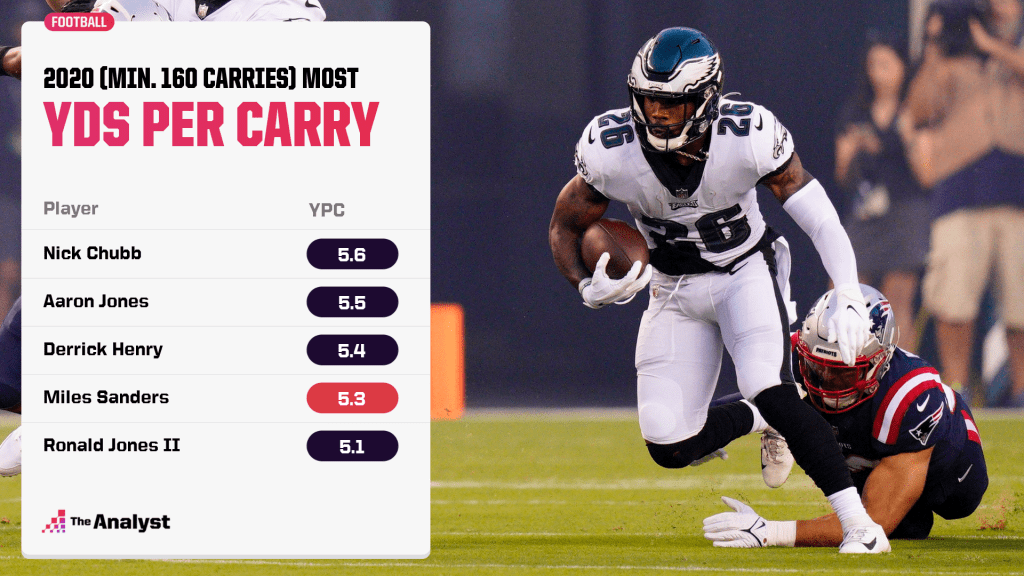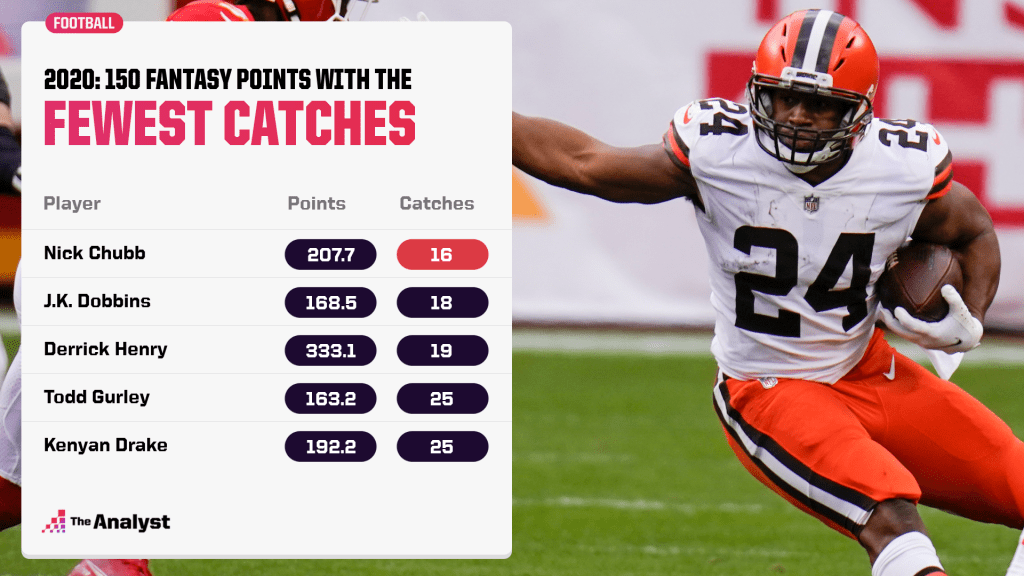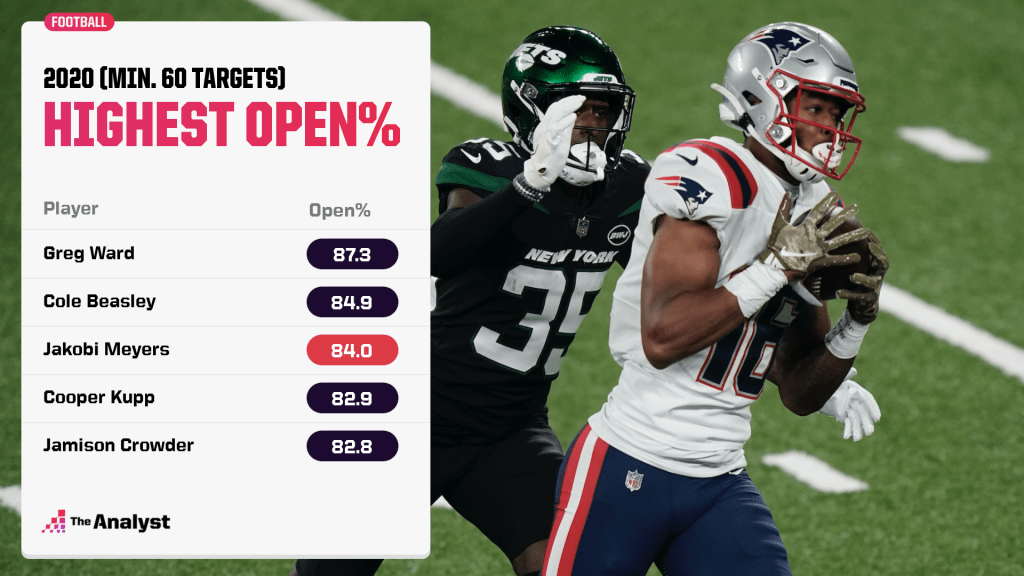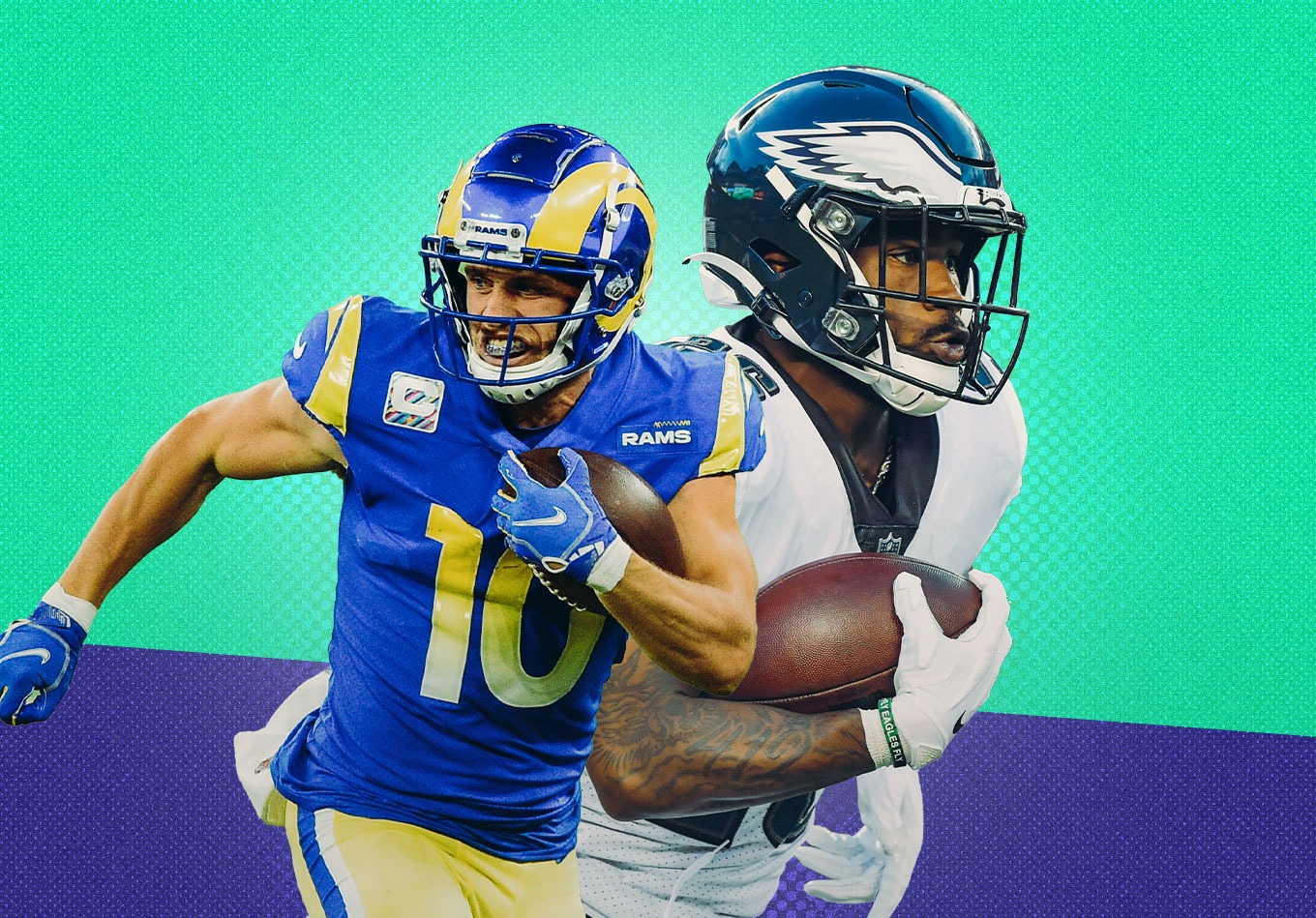We’re using our projection model to identify players who are great values with where they’re being selected in most fantasy drafts and those who might be a riskier selection at their current average draft position.
Two years ago, Christian McCaffrey had one of the great seasons in fantasy football history. Last year, Alvin Kamara was the only player with 900 rushing yards and 700 receiving yards.
In 2019, McCaffrey became only the third running back in NFL history to notch 1,000 rushing and receiving yards in a single season. As a result, the Carolina Panthers star ended the season as the top point-per-reception (PPR) scorer in fantasy football (including quarterbacks). He was so dominant, he outscored the next best running back by over 160 points, good for 10 points per game.
Simply put, McCaffrey didn’t just shatter his position mates in 2019, he also recorded the most fantasy points by any player in a single season in the last six years. Through three games last year, he was averaging 30 points per game, which was on pace to top his record-setting 2019 season.
Since 2017, no one – not even McCaffrey – has more receiving yards or more receiving big plays from the running back position than Kamara, who has 2,824 yards over that time and 20 plays of at least 25 yards. The New Orleans Saints star’s 2,660 yards after the catch are also No. 1 since 2017, ahead of McCaffrey’s 2,615.
However, McCaffrey and Kamara, our clear-cut, top-two PPR guys, aren’t on this list. Instead, we’re attempting to identify players who are great values with where they’re being selected in most fantasy drafts and those who might be a riskier selection at their current average draft position (ADP).
Below, you’ll see a name like Raheem Mostert on the list of running backs to draft. We’re not advocating that you draft him over Nick Chubb, who is on our list of running backs to be weary of come draft day. We’re just saying that Mostert’s ADP of 72 (RB27) is fantastic value, while Chubb may struggle to produce to his ADP of 10 (RB8).
Note: The ADPs for these players are coming from the consensus rankings at Fantasy Pros as of Sept. 1. For the purposes of this article and the ADP, we will be assuming a full PPR league format.
RBs to Draft Ahead of the Crowd
Miles Sanders, Philadelphia Eagles
Let’s start with a running back with a significant Pennsylvania flavor. The Penn State alum has caused some headaches for fantasy managers since entering the NFL. After a scintillating rookie year that caused Sanders’ ADP to soar entering last year, he came back to earth a little bit last season.
However, his decline in performance was due more to injury than anything else. And, when he was healthy, he performed even better in 2020. With a rushing average of 5.3 yards per carry that was fourth in the NFL among those with at least 160 carries, and six rushing touchdowns that doubled his output from his rookie season (in four fewer games), Sanders was on pace to continue his ascension into RB1 status.

With Jalen Hurts, the Eagles offense has the potential to be dynamic, and with a potentially great offensive line led by the fantastic Brandon Brooks (second behind Dallas Cowboys guard Zack Martin in our right guard projections), Sanders should have some open running lanes to attack.
While projecting time lost to injuries is tricky, that injury risk has been more than baked into his ADP. Currently being drafted late in the third round as RB19, however, is too late. He was healthy his final year in college and his entire rookie season, and with a return to health, Sanders has an excellent chance of finishing inside the top 10 at the running back position this year, making him a steal anywhere outside of the second round.
Mike Davis, Atlanta Falcons
Davis was the recipient of the majority of touches out of the Carolina backfield once McCaffrey went down last year and his production in that role makes for very promising prospects as he enters the season as the clear lead back for the Falcons.
Despite a rushing average of under 4.0 yards per carry, Davis made the best of a difficult situation. Among players with 150 carries on the year, Davis finished fifth in yards after contact (2.2) and third in tackles avoided per carry (0.24). This ability to churn a little bit more out of nothing, combined with some consistently excellent volume, vaulted Davis into a regular fantasy contributor.
It was in the passing game where Davis rode that significant volume to finish as RB12 in 2020. With over 4.0 catches per game in his final 14 games, Davis was the benefactor of an extremely high floor. With 50 receptions missing from the Falcons after the departures of Todd Gurley and Brian Hill, Davis can be the recipient of a similar workload in comparison with what he received in 2020.
This year, Davis is being drafted as RB22 and in the middle of the sixth round in a 10-team league. Again, remember, he finished 12th last season. Our projections are much more optimistic about Davis’ prospects of replicating his 2020 season than what is being reflected in his ADP.
If you can nab Davis with a fifth- or sixth-round pick in your draft, he’ll be well worth your investment as a high-end RB2.
Raheem Mostert, San Francisco 49ers
An analytics darling, all Mostert does when he gets the ball is produce. Maybe the fastest player in the NFL, the 2014 60- and 200-meter Big Ten track and field champion headlines a fantasy-friendly San Francisco rushing attack that is adding veteran center Alex Mack to contribute to what should be an above-average offensive line.
There are lots of positives about Mostert, but maybe the biggest is that unlike a lot of running backs, he does not need a ton of volume to produce gaudy numbers.
Let’s start with the simplest one: Although he does not have enough carries to qualify, his 5.6 career yards per carry is the highest in NFL history among running backs. Buoyed by a great ability to hit the hole in Kyle Shanahan’s zone running scheme, his 3.28 yards per rush before contact last season was fifth best in the NFL.
Of our top 24 running backs this season, Mostert is projected to get the fewest carries and touches of the entire group. Even then, our model likes Mostert’s chances of finishing higher than his current ADP of 70 (RB27).
And of course, Mostert’s situation is a prime example of a high upside draft pick. If he were to get increased volume, he might vault himself all the way to RB1 consideration.
RBs to Wait Out
Nick Chubb, Cleveland Browns
Based on football alone, Chubb may be the best pure rusher in the NFL. After two sensational seasons in a row, both Chubb’s counting and advanced stats are among the best in the NFL. Last season, he finished second in yards per carry (5.6), third in yards after contact per rush (2.59), fourth in total missed tackles forced (49), and he tied for the most broken tackles (16).
This is not a referendum on Chubb. This is all about his circumstances as a potential RB1 in fantasy football. The reality of his situation, however, is that he has such a productive running back counterpart in Kareem Hunt that he doesn’t often see as much volume as the other running backs being drafted in this area.
Where that comes through in abundance is in the passing game. Chubb caught only 16 passes last year, which was less than Derrick Henry (19). Henry, though, more than made up for it with nearly 200 more carries than Chubb, whose 16 catches were the fewest of any running back who scored 150 fantasy points last season.

Banking on a running back who is so reliant on production in the rushing game and specifically on rushing touchdowns (12 in 12 games last season) is tough. Banking on a running back who also faces stiff competition from his own teammate for touches (Hunt outscored Chubb in PPR last season) is tough. Doing so with a first-round running back is even tougher.
Jonathan Taylor, Indianapolis Colts
Taylor is coming off a dynamic rookie season in which he put up nearly 1,500 scrimmage yards and 12 touchdowns. However, as RB 10 and being drafted at the back end of the first round in most drafts, there are a lot of potential red flags for someone who you would typically draft at that spot.
For starters, the health of two critically important cogs in the Colts offense is in question. Both quarterback Carson Wentz and offensive guard Quenton Nelson are in a race against the clock to get back in time for Week 1. Even if both make it back from recent foot injuries, there is reason to question the level of performance from those two, and more importantly, Wentz’s ability to stay healthy throughout the season.
The other big question mark is the situation in Indy’s backfield. Last season, Taylor enjoyed a large volume, with the seventh most touches among all running backs. But that volume was in part due to the season-ending injury suffered by Marlon Mack. With Mack back and healthy, some of the workload will likely be reduced for Taylor, especially in the passing game.
Two or three fewer touches (and especially receptions) per game can be the difference between an RB1, which is what Taylor is being drafted to be, and a high-end RB2.
Clyde Edwards-Helaire, Kansas City Chiefs
This is all about opportunity. Pretend you are Andy Reid, and you have the ball at the opponent’s two-yard line. Are you running the ball, or are you putting the ball in the hands of your quarterback – some fellow named Patrick Mahomes?
If you’re picking Mahomes (like Reid probably is), that’s a problem. Here’s the real problem, though. In those situations last season, Reid provided CEH with plenty of chances. In fact, Edwards-Helaire had 14 carries in goal-to-go situations last season. He averaged 0.9 yards per carry in those situations and scored only once.
Because of this inefficiency, he needs volume. But that brings us back to the Mahomes dilemma. CEH isn’t going to be a primary option of this offense, especially if Tyreek Hill and Travis Kelce are healthy.
Edwards-Helaire will likely stack up some nice overall yardage totals again, but without touchdowns, it’s hard to vault into that high RB2 range, which is where he’s being drafted. Our projections reveal it’s more likely CEH finishes outside the top 20 in fantasy points than in the top 15.
WRs to Draft Ahead of the Crowd
Cooper Kupp, Los Angeles Rams
Let’s begin with the player who is currently the most undervalued in all of fantasy football. Currently being drafted as WR18, somewhere in the mid-to-late fifth round, Kupp is going to benefit from two major factors that could easily vault him into WR1 status as a top-10 performer at the WR position.
The first? How about upgrading your quarterback from Jared Goff to Matthew Stafford? In Sean McVay’s offense, Kupp has proven to be a target hog, averaging over 8.0 per game in each of the last two years. With Stafford in control of the offense, those targets should become more valuable.
The second? Kupp only scored three touchdowns last season. A return to the mean (he’s averaged better than one touchdown every two games throughout his career) means that Kupp is going much lower in drafts than where he should be.
Diontae Johnson, Pittsburgh Steelers
A common theme amongst the wide receivers in this group is they all receive a hefty number of targets. Johnson is no different. A notorious case of the drops, which resulted in a high-profile benching, is likely seeping its way into the minds of fantasy managers. Maybe it’s well deserved, but despite those issues, you know what his drops didn’t affect? His targets.
Johnson finished the season with 144 targets, good for sixth in the NFL in targets per game. He enters this year with an offensive line that is again likely to be woefully bad in the run game, meaning a pass-heavy offense isn’t out of the question. If you are looking for a dark horse to lead the NFL in catches this year, it’s Johnson.
Grabbing that sort of upside for your team is well worth your investment. Doing so in the sixth round, with Johnson currently going off the boards at WR21, is fantastic value.
He may not be a burner like Tyreek Hill, a touchdown machine like Davante Adams, or have hands like DeAndre Hopkins, but nothing is more valuable than catching the football in PPR formats. Johnson does that. He’s a worthy target of a fifth-round pick.
Jakobi Meyers, New England Patriots
News that Mac Jones is the starting QB for New England is even more helpful to Meyers’ prospects this season. With the Patriots seemingly moving away from a run-heavy offense that they ran last year with Cam Newton at the helm, Meyers is in prime position to take advantage of the newly found opportunities as the best wide receiver on the Patriots.
Of all players with more than 60 targets last season, Meyers got open at the third-best rate, getting open 84.0% of the time. With Newton leading the offense, targets weren’t an issue, as his target share of 28.7% was eighth best in the NFL. It was converting those targets into catches that was the issue. Jones should help solve that problem and help Meyers parlay his ability to get open into more receptions.

It’s reasonable, therefore, to look at Meyers and wonder why he is basically going undrafted as WR59. Well, in two seasons, Meyers still hasn’t scored a touchdown. That can’t possibly continue. Even a few touchdowns from Meyers to go along with some more targets would vault him into a position to be a solid Flex option.
He’s basically free to get and worth the flier.
WRs to Wait Out
DK Metcalf, Seattle Seahawks
Metcalf is without a doubt one of the most dynamic athletes in the NFL. He averaged over 15 yards per reception, scored 10 touchdowns, and had 15 plays of at least 25 yards in 16 games last season. Yet, he was maybe most known for a tackle he made to prevent a touchdown.
There’s no doubting his abilities, but with a current ADP that is seeing him drafted above players like Justin Jefferson and Keenan Allen, there are some major risks.
The key thing to remember as we think about the case against Metcalf is that in PPR formats, four catches for 90 yards is not as good as eight catches for 60 yards. Metcalf was so reliant on big plays, that he had five games last year of five or fewer catches and fifty or fewer yards. He also had four games of four or fewer catches and 90 or more yards. He has a lot of boom or bust in his game and ended the season with the fewest receptions among players with 120 targets.
He will be good for a few explosions this season, games like the one he had against San Francisco last year when he posted a line of 12 catches for 161 yards and two touchdowns. But with a receiver drafted in the second or early third round, you are looking for some consistency as well, and Metcalf hasn’t yet shown he can provide that.
CeeDee Lamb, Dallas Cowboys
As is true with the rest of the players we’re suggesting you avoid at their ADP, talent isn’t the problem with Lamb. Lost in the hoopla of Jefferson’s record-setting rookie season, Lamb just missed out on 1,000 receiving yards of his own with the likes of Andy Dalton and Ben DiNucci throwing him the ball. He was fantastic last year.
The difficulty with projecting Lamb’s performance is the challenge in parsing who is going to be getting most of the targets between the three-headed receiving monster in Dallas. Amari Cooper and Michael Gallup are also more than serviceable options, but Dallas may be looking more to running back Ezekiel Elliott with Dak Prescott coming off a gruesome injury.
If you are confident that Lamb will be the winner of the internal struggle in Dallas for targets, then he’s well worth a draft pick in the third round.
But with Cooper having 1,000 receiving yards in five of his six seasons and Gallup recording 1,100 receiving yards in Prescott’s last full healthy season, there are some major unknowns about how the ball is going to spread around in Dallas.
Data modeling by Kyle Cunningham-Rhoads. Design by Matt Sisneros.
